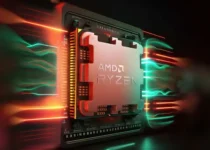Exploring the Steam Deck GPU: Performance and Graphics Card Equivalent
We answer your questions about what kind of graphics card is in the deck and what the Steam Deck GPU equivalent is. Of course, comparing discrete PC technology to a handheld device is more difficult, but there is a good match. Valve’s portable gaming console, which combines processing power and graphics processing, is built on a single AMD APU. We may now additionally contrast the OLED Steam Deck with the original.
Thus, it is impossible to compare them to traditional desktop graphics cards at best. We may nevertheless approximate a Steam Deck GPU equivalent to give you an idea of what PC video cards offer at the same level of performance. Sadly, an illustration of that kind does not give the complete story. To properly understand performance, we need to know how the Steam Deck APU varies from the standard desktop PC hardware. This is so because Valve created the Steam Deck using an AMD APU, or faster processing unit. These chips combine CPU and GPU functionality. As a result, the GPU in the Steam Deck is a component of a larger chip rather than separate.
You undoubtedly want to know the amount of power a Steam Deck has if you’re thinking about purchasing one. The difficulty in comparing the Steam Deck to other pieces of hardware is the issue. The AMD APU at the heart of Valve’s portable console combines central and visual processing into one device. At best, this makes comparisons with conventional desktop graphics cards difficult. Nevertheless, we can calculate the GPU equivalent of a Steam Deck to give you an idea of what PC cards have comparable performance levels.
What GPU is equivalent to Steam Deck?
It is challenging to draw comparisons between the hardware that powers the Steam Deck GPU and standard PC video cards. However, the GPU is about power equivalent to an Nvidia GTX 1050 or GTX 950 due to its maximum throughput of approximately 1.6 teraflops.
Sadly, a comparison like that doesn’t provide the whole picture. This is so because Valve designed the Steam Deck to be based on an accelerated processing unit (APU) from AMD. The GPU of the Steam Deck is not a separate graphics processing unit; rather, it is a component of a larger chip that houses both the CPU and the GPU. We must comprehend the distinctions between the Steam Deck APU and standard desktop PC hardware to properly comprehend performance.
The GPU equivalent of the Steam Deck is difficult to pinpoint because of its distinct architecture, which deviates slightly from the conventional PC’s. Although it uses the same RDNA 2.0 graphical architecture as consoles like the PS5, this does not mean that it is on par with such fully complete consoles. The form factor of the Steam Deck limits its processing capability; slower total clock rates translate into slower performance.
Thus, in terms of visual hardware, GPUs like the AMD Radeon RX 550 or the Nvidia GTX 1050 Ti are nearly equivalent to the Steam Deck. With just a few megabytes of RAM between them, both of these cards are somewhat antiquated in 2024, but the GPU architecture is what makes the Steam Deck competitive with more recent games and PCs. It is powered by a customized version of RDNA 2.0 that has been optimized and updated regularly over the handheld’s lifetime.
As a result, most games on the Steam Deck may be played at 1080p native resolution, with less visually demanding titles running at 60 frames per second. However, more demanding games can significantly deplete battery life and frame rate compared to games played on a console or PC. Better performance is ensured by patching in compatibility for contemporary games as the Steam Deck becomes more widely accessible and new versions, such as the Steam Deck OLED, hit the market.
Steam Deck GPU Equivalent: At A Glance
| Steam Deck Nvidia | GTX 1050 Ti | AMD Radeon R550 | |
| GPU Architecture | RDNA 2.0 (Custom) | Pascal GP107 | Polaris GCN |
| VRAM | 1-4GB | 4GB | 4GB |
| Boosted Clock Speed | 1.6GHz | 1.4GHz | 1.1GHz |
These specs provide the typical comparison between the Steam Deck and its GPU counterparts, even if they are subject to change.
The Power of the Steam Deck Graphics Card Equivalent
Having a strong graphics card is essential for portable gaming to guarantee fluid gameplay and amazing pictures. The gaming community is talking about the Steam Deck because of its innovative features and design. The Steam Deck’s comparable graphics card, which offers a desktop-like experience for gaming on a portable device, is one of the main features that distinguishes it. We will examine the features and in-depth information of the Steam Deck graphics card comparable in this article.
- NVIDIA Custom APU
The Steam Deck has a unique APU (Accelerated Processing Unit) that was created by NVIDIA especially to satisfy the demands of portable gaming devices. Gaming performance is made possible by this APU, which integrates the capabilities of a GPU (Graphics Processing Unit) and a CPU (Central Processing Unit) into a single chip. The Steam Deck’s NVIDIA Custom APU has outstanding graphics and a seamless gaming experience, akin to the architecture of high-end gaming PCs.
The RDNA 2 architecture, which is also the foundation for the newest generation of PC graphics cards, powers the graphics component of the NVIDIA Custom APU. This architecture improves the visual integrity of Steam Deck games with cutting-edge capabilities like variable rate shading and hardware ray tracing. By utilizing the Vulkan and DirectX 12 Ultimate APIs, developers may fully utilize the graphics card equivalent, producing visually spectacular and handheld device-optimized games.
Moreover, the NVIDIA Custom APU utilizes dedicated video memory to manage jobs requiring a lot of graphics.
This guarantees that the Steam Deck’s games have access to quick and effective memory, cutting down on loading times and enabling fluid gameplay—even for demanding titles. The Steam Deck is a potent handheld gaming device that can easily run AAA titles thanks to its powerful GPU as well as dedicated video memory.
- Performance and Optimization
The Steam Deck graphics card substitute is designed to provide outstanding effectiveness and speed. With its superior power management techniques, the custom APU maintains gaming performance while enabling extended battery life. Up to 1.6 teraflops of performance can be achieved by the GPU in the Steam Deck, which is equivalent to several mid-range PC graphics cards.
Even with its 7-inch LCD panel, the Steam Deck can deliver a fluid gaming experience because of the optimization work done by both Valve and NVIDIA. A feature called performance scaling has been added by Valve, which dynamically modifies the graphics settings according to the power and temperature constraints of the device. This strikes a balance between performance and battery life by guaranteeing that games on the Steam Deck run at their best frame rate and graphic quality.
Additionally, developers can utilize the optimization tools and capabilities of the Steam Deck because it is powered by SteamOS, an operating system based on Linux. Through the process of customizing their games for the hardware and software ecosystem of the Steam Deck, developers can maximize the device’s performance and provide players with an impeccable gaming experience.
- Versatility and Compatibility
The handheld device’s gaming capabilities are powered by the equivalent of a Steam Deck graphics card, which also allows for a variety of use cases. The Steam Deck may be used for productivity tasks like creating material and playing media, in addition to gaming. The robust GPU of the NVIDIA Custom APU guarantees fluid video editing and rendering, while its small size and integrated screen make it a handy portable entertainment device.
Additionally, the Steam Deck offers an amazing array of connections, including USB-C, Bluetooth connectivity, and Wi-Fi, enabling users to link external accessories and peripherals. The Steam Deck can be converted into a handheld gaming console for playing video games on bigger screens by connecting it to external displays. Furthermore, users can choose from a large selection of games thanks to the Steam Deck’s interoperability with the extensive Steam library, which increases the device’s adaptability as a gaming tool.
To sum up, the NVIDIA Custom APU-powered Steam Deck graphics card equivalent provides an incredible portable gaming experience. With its dedicated video memory, powerful GPU, and sophisticated optimization methods, the Steam Deck can rival some affordable PC graphics cards in terms of smooth gameplay and breathtaking visuals. The Steam Deck is a flexible tool for both productivity and gaming because of its many connectivity choices, compatibility, and versatility. The Steam Deck is at the vanguard of this movement, pushing the frontiers of handheld gaming while providing a distinct gaming encounter that redefines it.
Understanding Steam Deck specifications and performance
Here’s a brief overview of the standard features that all Steam Deck models have in common:
- CPU: Zen 2 4c/8t, 2.4-3.5GHz (up to 448 GFlops FP32)
- GPU: 8 RDNA 2 CUs, 1.0-1.6GHz (up to 1.6 TFlops FP32)
- RAM: 16GB LPDDR5 (5500 MT/s quad 32-bit channels)
Even while the Steam Deck’s GPU specifications seem modest on paper, its quick memory will significantly improve overall performance. The most recent version of low-power Double Data Rate memory, 16GB of four-channel LPDDR5 RAM, is part of the hardware. This memory is not only designed with mobile technology in mind, but its four channels give the APU an enormous amount of bandwidth.
Naturally, this complicates comparisons even further, as desktop video cards usually operate on a different GDDR memory pool. That is not how the Steam Deck operates. Rather, when needed, its GPU uses the common pool of memory.
The fact that the Steam Deck GPU is built on a far more energy-efficient architecture than other similar video cards in the same class just serves to muddle matters further. Although the specifications might appear lower than anticipated, the device will have a pretty strong performance compared to power consumption. Because of this, even though the GTX 1060 and the GeForce GTX 1660 have almost equal clock speeds and total power draws, the latter card can perform better.
It’s challenging to identify an exact GPU equivalent for Steam Deck for several reasons. Its APU functions differently from a desktop video card. Let’s just say that it’s around the same as an Nvidia GTX 1050. greater to the point, you probably already have access to greater graphical capability than the Steam Deck can offer if your PC uses a graphics card from 2018 or later.
FAQs
- Is the Steam Deck inferior to the MSI Claw?
Both the MSI Claw and the Steam Deck are gaming consoles with advantages and disadvantages of their own. While the Steam Deck is less expensive and features virtual memory, the MSI Claw performs better and has a longer battery life.
- Are portable game systems worthwhile?
The ability to have a portable device that you can carry with you is very alluring, even if gaming PCs and consoles typically surpass them. It’s worth the money to have a handheld console for lengthy commutes or even just for convenience.
- What is the RAM capacity of the Steam Deck?
The RAM on the Steam Deck is 16GB LPDDR5.
- Does RTX come with a Steam Deck?
No, as of this writing, the AMD APU that combines the Zen 2 CPU and RDNA 2 GPU is the graphics card found within the Steam Deck.
- In what ways is the Steam Deck different from gaming laptops?
Comparable gaming performance is provided by the Steam Deck and mid-range gaming laptops. Similar to laptops for gaming with graphics cards like the ones made by AMD Radeon RX 5600M or NVIDIA GeForce GTX 1660 Ti, it has a proprietary AMD APU with a quad-core Zen 2 CPU and an RDNA 2 GPU.
While gaming laptops could have better graphics cards and overall efficiency, the Steam Deck has the advantage of being portable and convenient enough to double as a handheld console in addition to being a specialized gaming device.
- Is it possible to upgrade the Steam Deck’s graphics card?
No, the GPU in the Steam Deck’s system cannot be upgraded. Since the device’s motherboard is connected to the custom AMD APU with integrated RDNA 2 GPU, it cannot be upgraded or changed. Nonetheless, the Steam Deck is made to strike a compromise between mobility and performance because it is a mobile gaming system. The majority of users should have a satisfying gaming experience thanks to the integrated graphics, which are already designed for gaming on the move.
Final Thoughts
We believe that there is a reasonable benchmark from a few GPU generations back, even though it’s difficult to define a precise Steam Deck GPU equivalent because of its antiquated hardware but optimized software. That doesn’t necessarily mean the Steam Deck is outdated, though, because, for a tenth of the price of an entirely equivalent PC, you can get a dedicated game machine with the Steam Deck.
In summary, the Steam Deck graphics card offers remarkable performance for a portable device and is comparable in power to a potent PC gaming GPU. Its unique AMD APU combines a powerful RDNA 2 GPU with a quad-core Zen 2 CPU, akin to what is seen in contemporary gaming consoles such as the Xbox Series X and PlayStation 5.


